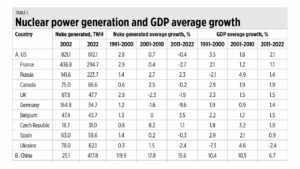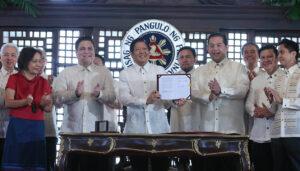The nuclear option to energize growth

The 2nd annual Ruperto P. Alonzo (RPA) Memorial Lecture will happen today, 3 p.m., at the University of the Philippines School of Economics (UPSE) in Diliman, Quezon City. The topic is “The Nuclear Option” and the economic implications. The event is jointly sponsored and funded by the UPSE-based Program in Development Economics Alumni Association (PDEAA) and the Philippine Center for Economic Development (PCED). PDE is a dear program of the late Prof. Ruping Alonzo who passed away in 2017 — today would have been his 76th birthday.
The main speaker will be Energy Undersecretary Sharon Garin, the panelists are Dr. Carlo Arcilla, Director of the Philippine Nuclear Research Institute (PNRI); Froilan Savet, First Vice-President and Head of Network of Meralco; Lino Bernardo, Head of Special Projects of Aboitiz Power; Paolo Pagaduan, Senior Lead for Renewable Energy and Just Transition, Asian Peoples’ Movement for Debt and Development (APMDD); and this writer as a PDE alumnus, batch 33rd (SY 1997-1999). The panel moderator will be Jay Layug, Senior Partner of Divina Law and a UPSE alumnus.
So, why the “nuclear option”?
NUCLEAR POWER AND INDUSTRIALIZATION
Almost all major industrial countries in the world have been powered partly or largely by nuclear energy since the 1960s and ’70s. The United Kingdom (UK) opened its first nuclear plant in 1956, and by 1965 its nuclear power generation was already 15.1 terawatt-hours (TWH) or 15,100 GWH. In 1965, the United States of America (US) was already generating 3.1 TWH through nuclear power, while that of France was producing 0.9 TWH.
Nuclear power is generally safe, cheap and highly reliable. Since the 1970s, there was only one major nuclear accident with high fatality, in Chernobyl, Ukraine in 1986. The latest nuclear accident in Fukushima, Japan in 2011 after a big earthquake and tsunami has zero fatality.
Even when some Western countries have reduced their nuclear power capacity, more Asian countries are turning to nuclear power to sustain their growth. From 2002 to 2022, these Asian countries have increased their nuclear power generation: China from 25 to 418 TWH, South Korea from 119 to 176 TWH, and India from 19 to 46 TWH. Major oil-gas producer and exporter United Arab Emirates quickly expanded its nuclear power generation from zero in 2019 to 10.5 TWH in 2021 and 20.1 TWH in 2022. Pakistan had 22.3 TWH generated by nuclear power in 2022.
Many countries that started “denuclearization” experienced slower GDP growth. In Table 1, one can see that France, the UK, Germany, Spain, Japan, and the US have shown this trend. In contrast, countries that expanded their nuclear power generation have experienced faster growth (at least 2.7% yearly), namely China, South Korea, India, and Pakistan. Taiwan has seen a trend in growth deceleration too, but it is still at 3.2% in the last decade.
WHY THE PHILIPPINES NEED NUCLEAR ENERGY, BADLY
Particularly for the Philippines, we need nuclear because it was coal power that saved us from possible daily “Earth Hours” every day for the past few decades and yet government has banned the building of new or greenfield coal plants since 2017. From 2008 (when the renewable energy law or RA 9513 was enacted) to 2022, the average increase of power sourced from wind was only 69 GWH/year, from solar, 94 GWH/year, and from biomass, 130 GWH/year. Power from geothermal and natural gas (Malampaya) was flat and even declining. Coal power was expanding by 3,620 GWH/year.
The implied capacity factor (ICF) — which compares the installed capacity with the actual generation — of intermittent renewables is low: 28% for wind, 25% for biomass, and 14% for solar. And yet they are favored by law and pushed by many sectors in the country and the world. Coal has a higher ICF of 61%, natural gas has an ICF of 55% (see Table 2).
The mothballed Bataan Nuclear Power Plant (BNPP) could have contributed some 4.6 TWH/year, assuming a capacity factor of 85%. That is bigger than the combined generation of solar plus wind of only 2.9 TWH in 2022. Small modular reactors (SMRs) and even micro modular reactors (MMRs) will greatly help many power-deficient on-grid islands and off-grid islands and provinces like Palawan, Mindoro, Masbate, Marinduque, Camiguin, Batanes, and so on.
I will discuss more of this in the PDEAA forum this afternoon. The event is open to the public and media, with no registration fee for both physical and online participants and will be streamed live on the UPSE Facebook page.
Again, the event is organized and funded by the PDEAA and PCED. But to be transparent, the PDEAA solicited some corporate donations and support, not for this particular forum but for the future PDEAA room at the expanded UPSE building. Our initial supporters are the Aboitiz Power Corp., Manila Electric Co. (Meralco), and Robinsons Retail Holdings, Inc. Thank you, guys, for your generosity and support. Your companies will be recognized inside that room once it is finished.
Bienvenido S. Oplas, Jr. is the president of Bienvenido S. Oplas, Jr. Research Consultancy Services, and Minimal Government Thinkers. He is an international fellow of the Tholos Foundation.




